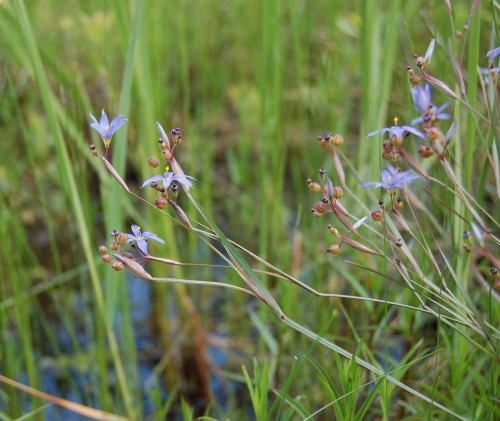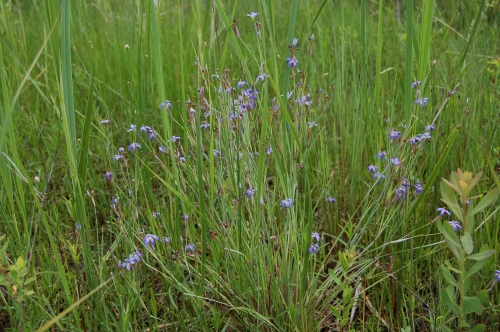Plants and Animals
Sisyrinchium strictum Blue-eyed-grass
Key Characteristics
Small loosely clustered forb of sandy soil; stems very narrow (<2 mm), appearing branched near the top; flowers blue, borne on long stalks (>15 mm).
Status and Rank
US Status: No Status/Not Listed
State Status: T - Threatened (legally protected)
Global Rank: G3 - Vulnerable
State Rank: S2 - Imperiled
Occurrences
| County | Number of Occurrences | Year Last Observed |
|---|---|---|
| Baraga | 1 | 1966 |
| Barry | 1 | 1979 |
| Gratiot | 1 | 1898 |
| Hillsdale | 1 | 1984 |
| Isabella | 1 | 1898 |
| Jackson | 1 | 1969 |
| Kent | 1 | 1942 |
| Lake | 3 | 2016 |
| Montcalm | 2 | 1966 |
| Newaygo | 1 | 1965 |
Information is summarized from MNFI's database of rare species and community occurrences. Data may not reflect true distribution since much of the state has not been thoroughly surveyed.
Habitat
This blue-eyed grass generally occurs in dry to moist prairies and rocky or sandy openings.
Natural Community Types
- Coastal plain marsh
- Dry southern forest
- Dry-mesic northern forest
- Dry-mesic prairie
- Dry-mesic southern forest
- Granite bedrock glade
- Hillside prairie
- Mesic prairie
- Mesic sand prairie
- Oak barrens
- Oak openings
- Oak-pine barrens
For each species, lists of natural communities were derived from review of the nearly 6,500 element occurrences in the MNFI database, in addition to herbarium label data for some taxa. In most cases, at least one specimen record exists for each listed natural community. For certain taxa, especially poorly collected or extirpated species of prairie and savanna habitats, natural community lists were derived from inferences from collection sites and habitat preferences in immediately adjacent states (particularly Indiana and Illinois). Natural communities are not listed for those species documented only from altered or ruderal habitats in Michigan, especially for taxa that occur in a variety of habitats outside of the state.
Natural communities are not listed in order of frequency of occurrence, but are rather derived from the full set of natural communities, organized by Ecological Group. In many cases, the general habitat descriptions should provide greater clarity and direction to the surveyor. In future versions of the Rare Species Explorer, we hope to incorporate natural community fidelity ranks for each taxon.
Associated Plants
Lousewort, Hill's thistle, dewberry, panic grass, wood rush, grass-leaved rush, sheep sorrel, prairie ragwort, jack pine, meadow-sweet, blue-joint grass, arrow-leaved violet, prairie cordgrass, and black-fruited spikerush.
Management Recommendations
This species is poorly understood, but it likely benefits from maintaining areas in an open condition through protection of hydrology, removal of excessive brush, and occasional prescribed fires.
Survey Methods
Random meander search covers areas that appear likely to have rare taxa, based on habitat and the judgement of the investigator.
-
Meander search
-
Survey Period: From first week of July to fourth week of July
-
References
Survey References
- Elzinga, C.L., D.W. Salzer, and J.W. Willoughby. 1998. Measuring and Monitoring Plant Populations. The Nature Conservancy and Bureau of Land Management, Denver. BLM Technical Reference 1730-1. 477pp.
- Goff, G.F., G.A. Dawson, and J.J. Rochow. 1982. Site examination for Threatened and Endangered plant species. Environmental Management 6(4): 307-316
- Nelson, J.R. 1984. Rare Plant Field Survey Guidelines. In: J.P. Smith and R. York. Inventory of rare and endangered vascular plants of California. 3rd Ed. California Native Plant Society, Berkeley. 174pp.
- Nelson, J.R. 1986. Rare Plant Surveys: Techniques For Impact Assessment. Natural Areas Journal 5(3):18-30.
- Nelson, J.R. 1987. Rare Plant Surveys: Techniques for Impact Assessment. In: Conservation and management of rare and endangered plants. Ed. T.S. Elias. California Native Plant Society, Sacramento. 8pp.
Technical References
- Flora of North America Editorial Committee. 2002. Flora of North America, North of Mexico. Volume 26: Magnoliaphyta: Liliidae: Liliales and Orchidales. Oxford University Press, New York. 723pp.
- Gleason, H. A., and A. Cronquist. 1991. Manual of Vascular Plants of Northeastern United States and Adjacent Canada. Second edition. The New York Botanical Garden, Bronx. 910pp.
- Gray, A. 1950. Gray's Manual of Botany; eighth ed. Van Nostrand Reinghold, New York. 1632pp.
- Holmgren, N.H. 1998. Illustrated Companion to Gleason and Cronquist's Manual. Illustrations of the vascular plants of Northeastern United States and adjacent Canada. New York Botanical Garden, Bronx. 937pp.
- Voss, E. G. 1972. Michigan Flora. Part I. Gymnosperms and Monocots. Bulletin of the Cranbrook Institute of Science and University of Michigan Herbarium. 488pp.



